Mythology of Italy
| Mythology |
|---|
| Part of a series on the |
| Culture of Italy |
|---|
 |
| People |
| Traditions |
The mythologies in present-day Italy encompass the
Roman mythology
Roman mythology also draws directly on
Latin literature was widely known in Europe throughout the
Nature of Roman myth
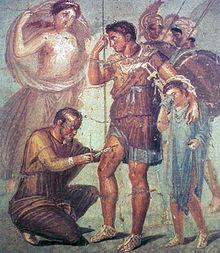
Because ritual played the central role in Roman religion that myth did for the Greeks, it is sometimes doubted that the Romans had much of a native mythology. This perception is a product of Romanticism and the classical scholarship of the 19th century, which valued Greek civilization as more "authentically creative."[2] From the Renaissance to the 18th century, however, Roman myths were an inspiration particularly for European painting.[3] The Roman tradition is rich in historical myths, or legends, concerning the foundation and rise of the city. These narratives focus on human actors, with only occasional intervention from deities but a pervasive sense of divinely ordered destiny. In Rome's earliest period, history and myth have a mutual and complementary relationship.[4] As T. P. Wiseman notes:
The Roman stories still matter, as they mattered to
tyranny?[3]
Major sources for Roman myth include the .
Founding myths
The Aeneid and Livy's early history are the best extant sources for
Other myths

The characteristic myths of Rome are often political or moral, that is, they deal with the development of Roman government in accordance with divine law, as expressed by Roman religion, and with demonstrations of the individual's adherence to moral expectations (mos maiorum) or failures to do so.
- Rape of the Sabine women, explaining the importance of the Sabinesin the formation of Roman culture, and the growth of Rome through conflict and alliance.
- Numa Pompilius, the Sabine second king of Rome who consorted with the nymph Egeria and established many of Rome's legal and religious institutions.
- Servius Tullius, the sixth king of Rome, whose mysterious origins were freely mythologized and who was said to have been the lover of the goddess Fortuna.
- The Tarpeian Rock, and why it was used for the execution of traitors.
- early Roman monarchyand led to the establishment of the Republic.
- Cloelia, a Roman woman taken hostage by Lars Porsena. She escaped the Clusian camp with a group of Roman virgins.
- Horatius at the bridge, on the importance of individual valor.
- Mucius Scaevola, who thrust his right hand into the fire to prove his loyalty to Rome.
- Praeneste.[6]
- Manlius and the geese, about divine intervention at the Gallic siege of Rome.[7]
- Stories pertaining to the Nonae Caprotinae and Poplifugia festivals.[8]
- Coriolanus, a story of politics and morality.
- The Etruscan city of Corythus as the "cradle" of Trojan and Italian civilization.[9]
- The arrival of the Great Mother (Cybele) in Rome.[10]
Etruscan mythology
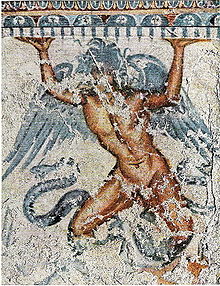
The mythology is evidenced by a number of sources in different media, for example representations on large numbers of pottery, inscriptions and engraved scenes on the Praenestine cistae (ornate boxes; see under Etruscan language) and on specula (ornate hand mirrors). Currently some two dozen fascicles of the Corpus Speculorum Etruscorum have been published. Specifically Etruscan mythological and cult figures appear in the Lexicon Iconographicum Mythologiae Classicae.[12] Etruscan inscriptions have recently been given a more authoritative presentation by Helmut Rix, Etruskische Texte.[13]
Gods and Goddesses
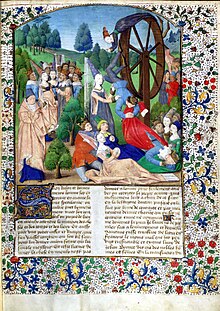
Important Gods and Goddesses of Italian Mythology:
- Aradia is the Italian Goddess of witchcraft. She protects witches (male and female) against the aggression of religious persecution and condemnation and symbolizes the air element and the moon.
- Carmenta is the Goddess of spells, known for chanting incantations in verse to ease the pains of women in labor and children facing illness.
- Februus is the Italian God of purification who lives in the underworld.
- Fortuna is the Goddess of fate and fortune and also bringer of fertility.
- Jana is the Goddess of the Moon, said to have 2 faces. One faces the past, and the other faces the future.
- Joveis the Sky God. He is the equivalent of Jupiter of Roman mythology who is the King of all other Gods.
- Nox is the Goddess of the night, the beginning of all things, and one of the oldest of the Gods.
- Umbria is Goddess of shadows, secrets, darkness who lives in the underworld.
- Cel is the Etruscan Goddess of earth. She was the mother of Giants, a race of great strength and aggression.
Cultural phenomena
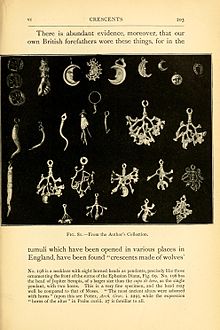
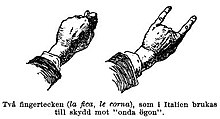
The evil eye, in Italian malocchio, is not just a part of Italian folklore but is also present in many different cultures. The evil eye is a supernatural belief in a curse brought about by a malevolent glare, usually inspired by envy.[14] The belief in the evil eye among humans has existed since prehistory,[14] and amulets to protect against it have been found from dating to about 5,000 years ago.[14] It is estimated that around 40% of the world's population believes in the evil eye.[15]
It is found in many cultures in the
Different cultures have pursued measures to protect against the evil eye.
The cornicello, "little horn", also called in Italian the cornetto ("little horn", plural cornetti), is a long, gently twisted horn-shaped amulet. Cornicelli are usually carved out of red coral or made from gold or silver. The type of horn they are intended to copy is not a curled-over sheep horn or goat horn but rather like the twisted horn of an African eland or a chili pepper.[19] A tooth or tuft of fur of the Italian wolf was worn as a talisman against the evil eye.[20]
One idea that the
The wielder of the evil eye, the jettatore, is described as having a striking facial appearance, high arching brows with a stark stare that leaps from his eyes. He often has a reputation for clandestine involvement with dark powers and is the object of gossip about dealings in magic and other forbidden practices. Successful men having tremendous personal magnetism quickly gain notoriety as jettatori. Pope Pius IX was dreaded for his evil eye, and a whole cycle of stories about the disasters that happened in his wake were current in Rome during the latter decades of the 19th century. Public figures of every type, from poets to gangsters, have had their specialized abilities attributed to the power of their eyes.[21]
See also
- Roman mythology
- Etruscan mythology
- Greek mythology
References
- ^ Rengel, Marian; Daly, Kathleen N. (2009). Greek and Roman Mythology, A to Z. United States: Facts On File, Incorporated. p. 66.
- ^ T. P. Wiseman, The Myths of Rome (University of Exeter Press, 2004), preface (n.p.).
- ^ a b Wiseman, The Myths of Rome, preface.
- ^ Alexandre Grandazzi, The Foundation of Rome: Myth and History (Cornell University Press, 1997), pp. 45–46.
- ^ See also Lusus Troiae.
- ^ J.N. Bremmer and N.M. Horsfall, Roman Myth and Mythography (University of London Institute of Classical Studies, 1987), pp. 49–62.
- ^ Bremmer and Horsfall, pp. 63–75.
- ^ Bremmer and Horsfall, pp. 76–88.
- ^ Bremmer and Horsfall, pp. 89–104; Larissa Bonfante, Etruscan Life and Afterlife: A Handbook of Etruscan Studies (Wayne State University Press, 1986), p. 25.
- ^ Bremmer and Horsfall, pp. 105–111.
- ISBN 0-292-70687-1.
- ^ "An illustrated lexicon about the ancient myths". Foundation for the Lexicon Iconographicum Mythologiae Classicae (LIMC). 2009. Retrieved 21 June 2009.
- ISBN 3-8233-4240-1. 2 vols.
- ^ a b c Hargitai, Quinn (19 February 2018). "The strange power of the 'evil eye'". BBC. Archived from the original on 9 February 2021. Retrieved 5 January 2021.
- JSTOR 644689.
- .
- ISBN 978-0-88125-463-1.
- ^ Smith, Elaine (6 December 2019). "Beware the Evil Eye. Or Buy One, Just for Kicks (Published 2019)". The New York Times. Archived from the original on 14 January 2021. Retrieved 5 January 2021.
- ^ Lucky Mojo. "The Corno (Italian Horn Amulet)". Archived from the original on 1 September 2013. Retrieved 9 February 2015.
- ^ (in Italian) Altobello, G. (1921), Fauna dell'Abruzzo e del Molise. Mammiferi. IV. I Carnivori (Carnivora) Archived 2016-05-04 at the Wayback Machine, Colitti e Figlio, Campobasso, pp. 38–45
- ISBN 0-231-04006-7.
